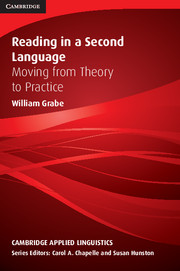Book contents
- Frontmatter
- Contents
- Series editors' preface
- Preface
- I FOUNDATIONS OF READING
- II PATTERNS OF VARIATION IN READING
- III DEVELOPING READING COMPREHENSION ABILITIES
- Chapter 10 Building main-idea comprehension
- Chapter 11 Becoming a strategic reader
- Chapter 12 Building awareness of discourse structure
- Chapter 13 Vocabulary and reading comprehension
- IV EXPANDING READING COMPREHENSION SKILLS
- References
- Author Index
- Subject Index
Chapter 13 - Vocabulary and reading comprehension
from III - DEVELOPING READING COMPREHENSION ABILITIES
Published online by Cambridge University Press: 05 August 2012
- Frontmatter
- Contents
- Series editors' preface
- Preface
- I FOUNDATIONS OF READING
- II PATTERNS OF VARIATION IN READING
- III DEVELOPING READING COMPREHENSION ABILITIES
- Chapter 10 Building main-idea comprehension
- Chapter 11 Becoming a strategic reader
- Chapter 12 Building awareness of discourse structure
- Chapter 13 Vocabulary and reading comprehension
- IV EXPANDING READING COMPREHENSION SKILLS
- References
- Author Index
- Subject Index
Summary
It is difficult to see how even a conservative estimate of English vocabulary could go much below a million lexemes. More radical accounts, allowing in all of science nomenclature, could easily double that figure. Only a small fraction of these totals, of course, are learned by any one of us.
(Crystal, 1995: 119)Over the past 15 years, there has been an increasing number of important research studies, review chapters, and books on the learning and teaching of vocabulary. A review of many current surveys of L1 and L2 vocabulary reveals a fairly standard set of questions that are posed and then answered. For example, what does it mean to know a word? How many words are there in English? How many words can be learned from the reading context? Should vocabulary be taught directly? How many words can be taught? (Baumann & Kame'enui, 2004; Bogaards & Laufer, 2004; Folse, 2004; Hiebert & Kamil, 2005; Nation, 2001; Schmitt, 2000; Stahl & Nagy, 2006; Wagner, Muse, & Tannenbaum, 2007b). Furthermore, most publications addressing vocabulary learning make strong connections between reading and the learning of written forms of words. There are, of course, good reasons for this connection between vocabulary and reading. This chapter departs somewhat from the format of other chapters in this book – it addresses the questions listed above (and others) in the process highlighting the promising relationship between reading and vocabulary.
The reading–vocabulary relationship
In L1 reading research, many studies demonstrate the strong relationship between vocabulary and reading.
- Type
- Chapter
- Information
- Reading in a Second LanguageMoving from Theory to Practice, pp. 265 - 286Publisher: Cambridge University PressPrint publication year: 2008



